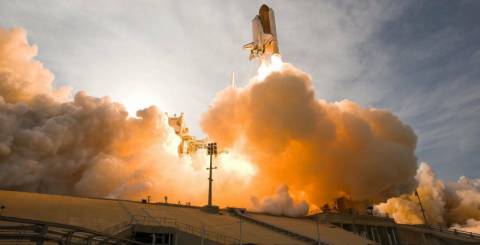Voyager Heads to Dog Star on its Never-ending Mission

NASA’s Voyager Interstellar Mission (VIM) is still making news headlines nearly 5 decades after its official launch in 1972. Thanks to the skills and efforts of much-dedicated personnel, the Voyager 1 and 2 spacecraft — which are still fully operational, has delivered unprecedented knowledge about the outer planets that had never existed in all history of planetary science and astronomy.
A Dollar Well Spent
If you’re wondering about expenditure, the Voyager mission cost $865 million from May 1972 to the October 2, 1989, Neptune encounter. The returns, however, have been fantastic for science and when compared with normal economic expenditures, are not that big. In total, by the completion of the Neptune encounter, 5 trillion bits of scientific data had been sent back to Earth by both spacecraft — enough bits to fill over 7,000 music CDs.
Voyager 2 is now in its protracted mission to study the outward reaches of the Solar System and, as of December 28, 2018, has been operational for 41 years, 4 months and 8 days. Both ships remain in contact with earth via the NASA Deep Space Network.

Into the Heliopause
Throughout the ages, astronomers have never been able to agree on where the solar system actually ends. Some say the boundary is where the Sun’s gravity no longer dominates.
This rather indistinct boundary is about halfway to Proxima Centauri, the nearest star. If the Voyagers travel at over 35,000 miles per hour, it will take them close to 40,000 years to reach it after having traveled for about 2 light years.
Another less ambiguous frontier, which the spaceships will approach and pass through is the heliopause — the boundary area where the cold emitted from interstellar space and the hot solar wind meet. When the Voyagers cross the heliopause they will be in interstellar space albeit still be a very long way from “the solar system’s edge.”
Once in interstellar space, the Voyager will be engrossed in material emitted from explosions of nearby stars. Thus, in a way, the heliopause might be seen as the final frontier. However, they may survive until around 2025, when dwindling levels of power and hydrazine will thwart further operation.
If it wasn’t for these declining consumables, earth’s tracking antennas would be able to continue “talking” with the Voyagers for about another one or two centuries!

Next Stop? Sirius
So, where does the VIM stand right now? NASA's famed Voyager 2, the only spacecraft to ever photograph Neptune and Uranus, left the heliosphere — the protecting 'bubble' of particles and magnetic fields (solar wind) created by the sun — on November 5, and actually entered the heliopause.
In 2012 Voyager 1 traversed the heliopause, but neither has ever departed from the solar system. The solar system’s boundary is believed to be past the outside edge of the Oort Cloud, a small group of objects that remain influenced by the gravity of the Sun. According to NASA, it will be around 300 years before Voyager 2 reaches the Cloud’s inner edge and perhaps over 30,000 years to travel past it.

NASA to Decide on Orbiting Lunar Base Early 2019
Meanwhile, the Voyager 2 is now headed for the bright Sirius, the 'Dog Star' as it searches for the heliopause boundary. Why is reaching it so important to pass this milestone? Well, penetrating the boundary will allow Voyager to take measurements of the interstellar fields, waves, and particles unaffected by solar wind.
In just 40,000 years, the Voyager 2 shall pass 1.7 light years from the Ross 248 star, and in around 296,000 years, will pass 4.3 light years from the Sirius star, which can be seen in winter from the northern hemisphere.
If you’re now staring avidly into the sky don’t strain your neck or eyes — traveling at 38,000 mph (61,155.07 kph) and now at a little over 11 billion miles (18 billion km) from Earth, it’s not likely that you’ll spot a Voyager no matter what hemisphere you’re in!
Similar Articles
Explore how data science is transforming the fintech industry, driving innovation, improving decision-making, and revolutionizing financial services.
In today's competitive business environment, companies are continually seeking ways to enhance efficiency, improve decision-making, and streamline operations. Enterprise Resource Planning (ERP) software has emerged as a vital solution, integrating various business processes into a cohesive system
Ultrasonic cleaning is a powerful, non-invasive method for removing contaminants from surfaces. Using high-frequency sound waves, ultrasonic cleaners create microscopic bubbles that implode upon contact with dirt, oils, or grime, effectively lifting them off.
When we think about efficient transportation within large buildings or crowded areas, we often imagine escalators or elevators. However, there’s another key player in the world of horizontal transportation: moving walkways.
Discover 6 essential IT security policies to protect your organization from cyber threats. Build a robust, compliant, and secure infrastructure today!
Nowadays, the IT world is not imaginable without the cloud. It is extremely difficult to replace the cloud because the technology is bound to evolve. In this constantly changing technology world, nothing can be forecasted. Nevertheless, the cloud has deployed itself in such a way that has become irreplaceable.
A Data Management Platform (DPM) can be defined as a smart assistant that collects data or information from various places, such as websites, apps, and customer databases. A detailed description of the customers is then generated, which contains information about their preferences and behavior
Software testing is imperative to the software development lifecycle, typically ensuring that applications work as intended and fulfill user expectations. Test Data Management (TDM) has become a rather crucial aspect of effective software testing.
It has been amply evident that there is a keen focus on delivering quality software products quickly. Here, DevOps emerges as an effective solution to meet such market demands. After all, it enables organizations to accelerate software delivery while improving business outcomes.









